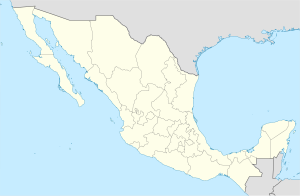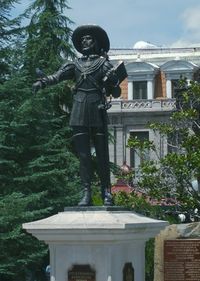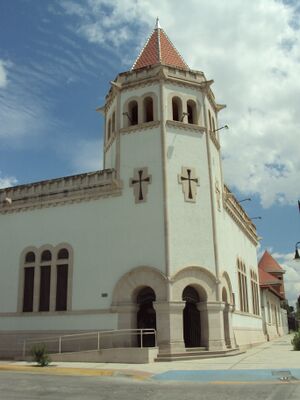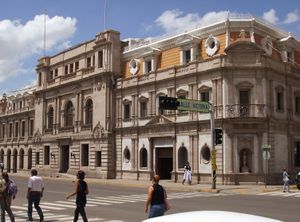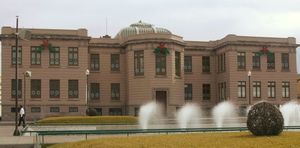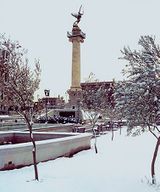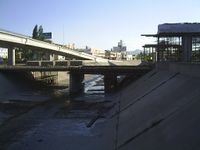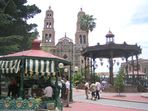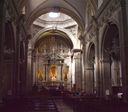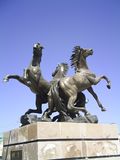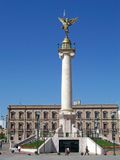تشيواوا (مدينة)
مدينة چيواوا
City of Chihuahua Ją’éłąyá (Lipan Apache) Chihuahua City Ciudad de Chihuahua | |
|---|---|
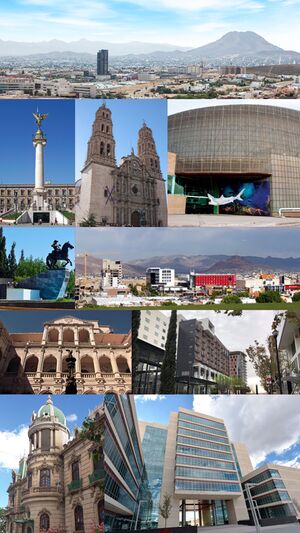 Left to right by row, from top to bottom: Chihuahua cityscape featuring Cerro Grande, the Angel of Liberty monument, Metropolitan Cathedral of Chihuahua, Semilla Museum Center of Science and Technology, Glorieta for Pancho Villa, Chihuahua cityscape featuring District 1, Government Palace of Chihuahua, District 1 neighborhood, Quinta Gameros University Cultural Center, State Supreme Tribunal of Justice building. | |
| الشعار: Valentía, Lealtad, Hospitalidad (ترجمتها: الشجاعة، الولاء، حسن الضيافة) | |
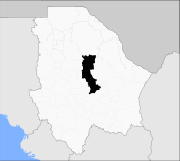 موقع المدينة في ولاية چيواوا. | |
| الإحداثيات: 28°38′07″N 106°05′20″W / 28.63528°N 106.08889°W | |
| البلد | |
| الولاية | |
| البلدية | |
| تأسست | 12 أكتوبر 1709 |
| أسسها | أنطونيو دى ديزا إل يلوا |
| الحكومة | |
| • القاضي | ماريا أوخنيا كامپوس گالڤان (حزب الحركة الوطنية) |
| المنسوب | 1٬415 m (4٬635[1] ft) |
| التعداد (2013) | |
| • الإجمالي | 925٬970 |
| • صفة المواطنة | چيواوي |
| منطقة التوقيت | UTC−7 (MST) |
| • الصيف (التوقيت الصيفي) | UTC−6 (MDT) |
| الرمز البريدي | 31000 |
| مفتاح الهاتف | +52 614 |
| المناخ | شبه مداري |
| الموقع الإلكتروني | / City of Chihuahua |
مدينة تشيواوا (إسپانية: Ciudad de Chihuahua [sjuˈða(ð) ðe tʃiˈwawa]; ليپان: Ją’éłąyá)، هي عاصمة ولاية چيواوا، المكسيكية.[2][1] يبلغ عدد سكانها حوالي 925.970 نسمة. النشاط السائد في المدينة هو الصناعة، ويشمل الصناعات الثقيلة، الخفيفة، انتاج السلع الاستهلاكية، وصناعات الماكيلادورا على نطاق أضيق.
Among cities in Mexico, the city of Chihuahua is highly ranked in human and social development. According to a UNDP[بحاجة لمصدر] report on human development, Chihuahua municipality's HDI is 0.840 as of 2015 – this is equal or higher than some Western European countries, with the literacy rate in the city among the highest in the country at 99%. Another report about competitiveness from the CIDE organization ranks Chihuahua as the second most competitive city in the country just behind Monterrey and ahead of Mexico City.[3] This report also ranks Chihuahua as the most Socially Competitive city in the country.[3]
The predominant activity is industry, including domestic heavy, light industries, consumer goods production, and to a smaller extent maquiladoras. The city is served by the General Roberto Fierro Villalobos International Airport.
التاريخ
It has been said that the name derives from the Nahuatl language, meaning "between two waters", other accepted definitions are "place of the holed-rock"[4] or from Tarahumara, "dry and sandy place".[5] The name itself is older than the Spanish conquest of Mexico. The city was founded on October 12, 1709, by Blas Cano de los Rios and Antonio Deza y Ulloa, a Spanish explorer, as El Real de Minas de San Francisco de Cuéllar.[6][7] Don Ildefonso de Irigoyen donated the land for the city foundation.[5] The town was erected a Villa in 1718 (or 1715)[1] with the name of San Felipe el Real de Chihuahua, and the name was shortened in 1823.
The location was chosen because it is the intersection of the rivers Chuviscar and Sacramento. It is also the midpoint between the Río Bravo del Norte (Rio Grande) and the then-important mining city of Hidalgo del Parral. For much of the 18th century, Chihuahua served as the de facto capital of Nueva Vizcaya because most governors preferred to reside there rather than in Durango, the capital of the province at that time.[8]
Just as in other parts of Northern Mexico, Roman Catholic missionaries were an important influence during the colonial era, and the city became a meeting point for missionaries heading to and from the 'sierra', the mountainous region in western Chihuahua State where the native Tarahumara still live.
During the War of Independence, the city saw little action. However, it was in Chihuahua where Miguel Hidalgo, considered the Father of the Country, was held prisoner in the Federal Palace of Chihuahua and executed in 1811 at the nearby Government Palace by the Spaniards.
During the Mexican–American War, Chihuahua fell to U.S. forces in 1847, after the Mexican Army was defeated at the Battle of the Sacramento, 15 ميل (24 km) north of the city.
During the French invasion, President Benito Juárez made the city the seat of his government-in-exile from 1864 to 1867. During the presidency of Porfirio Díaz the city experienced explosive growth and became one of the most important cities in Mexico. The city became the seat for important banks and wealthy families.
The city was more involved during the Mexican Revolution (1910–1917), for it became at times the operations base for the División del Norte, the army led by Pancho Villa. Many sites and memories remain of the Revolutionary era; the most important of these is the Historical Museum of the Mexican Revolution at Villa's former estate house near downtown Chihuahua. La Quinta Luz was turned into a museum by his widow, Sra. María Luz Corral de Villa, and is now managed by the federal government.
During the 20th century, the city grew in population and learned to take advantage of its proximity with the U.S. border. Until the establishment of foreign manufacturing plants in the 1970s, the city was largely a trade post for cattle and agricultural products. During the 1990s the city grew dramatically economically, becoming the third wealthiest municipality (per capita) in the republic, after Benito Juárez borough of the Federal District (Mexico City), and San Pedro Garza García in Nuevo León.
In 2002, Mayor Jorge Barousse Moreno from the Institutional Revolutionary Party (PRI) died and was succeeded by Alejandro Cano Ricaud. During Cano's administration, the city experienced dramatic growth in the security sector when the Police Department was certified by the ISO and surveillance aircraft bought.
Between 2002 and 2005, the city experimented with the introduction of certain new commercial innovations, like the first large mall in the city, Plaza del Sol, and the rise of the commercial Zone of the Sun, all along the Periférico de la Juventud, one of the main thoroughfares in the city.
In 2004 Juan Blanco Zaldívar, of the National Action Party (PAN), won the election for mayor (municipal president) of the city for the term 2004–2007. Since 2005, the International Festivals of Chihuahua have been celebrated by both the state and city governments during the months of September/October with art shows, plays, stage presentations and concerts by such bands as America, Foreigner, Creedence and Los Lobos being held at venues throughout the city.
Elections for mayor for the term 2007–2010 were held at the beginning of July 2007; Carlos Borruel Baquera of the PAN defeated former mayor Alejandro Cano Ricaud (PRI) by less than one-quarter of a percentage point of almost 200,000 votes cast. The turnout of registered voters, at about 41%, was the lowest in years.
In January, 2010, Mayor Carlos Borruel submitted his resignation in order to campaign for election to the office of Governor of Chihuahua. His deputy, Lic. Alvaro Guillermo Madero Muñoz, assumed the office of mayor for the balance of his term. On July 4, 2013, Javier Garfio Pacheco of the PRI won election for a 3-year term as mayor.
In December 2015, Eugenio Baeza Fares assumed office as mayor of the City of Chihuahua, after Javier Garfio Pacheco requested licence to pursue the possibility to become the candidate for the political party PRI to Governor of the State of Chihuahua.[9] After Garfio lost his bid for Governor Candidate, he returned and ended his period as mayor.[10]
In July 2016, María Eugenia Campos Galván (PAN) was elected mayor.[11] Her term started on October 10, 2016, and is expected to last for two years, with the possibility of reelection for three more years.[12]
Execution of Miguel Hidalgo y Costilla depicted in a mural by Aarón Piña Mora in the Government Palace of Chihuahua.
Panel of Piña mural in the Government Palace, honouring the liberators Abraham Lincoln, Benito Juárez and Simón Bolivar
Pancho Villa's bullet-riddled Dodge in the Historical Museum of the Mexican Revolution
Foundation
The origin of the city of Chihuahua begins with the discovery of the nearby mines and foundation of the population of Santa Eulalia in 1652 by Spanish captain Diego del Castillo, however; due to the climate and constant attacks of the indigenous people the exploitation was suspended and Santa Eulalia remained several years uninhabited. Some fifty years later, in 1707, more wealthy mining discoveries were made, leading to the immediate population of Santa Eulalia and its prosperity.
However, Santa Eulalia is located in the middle of a mountain range and the difficult terrain hindered the construction and expansion of the city; because of this, when in 1709 the governor of Nueva Vizcaya, Antonio de Deza y Ulloa, with the instruction to found the head of the Real de Minas visited the population, decided to convene 16 notable neighbors (miners, traders, government officials and priests) to resolve with them the desirability of setting up Santa Eulalia herself at the head of the Royal de Minas or founding for them a new population in the nearby valley where the rivers converged Rio Chuvíscar' Chuvíscar and Sacramento.
On 12 October 1709[13] the vote of the notables was held on the founding of the Royal de Minas, eight of them voted for establishment in Santa Eulalia itself, while the remaining eight did so for foundation in the valley. Faced with the tie, the governor Deza and Ulloa intervened with his deciding vote for foundation in the valley of the junta de los ríos; this is what is seen as the official foundation of Chihuahua and Antonio Deza and Ulloa as its founder. The new Real de Minas was founded under the name of Real de Minas de San Francisco de Cuéllar in honor of the then Viceroy of New Spain, Francisco Fernández de la Cueva Enríquez, 10th. Duke of Alburquerque and Marquis de Cuéllar.
Spanish Colony
The growth of the Real de Minas, driven by mines and activity of the surrounding farms continued during the colony; because of this on October 1, 1718, it stands at the Royal of San Francisco de Cuéllar in Villa, with the name of San Felipe el Real de Chihuahua'; Saint Philip in honor of the king Felipe V of Spain and being used for the first time the name of Chihuahua. At this time it is also solved the construction of a parish temple worthy for the village, to that end, the city council decided to impose a special tax on silver extracted from the mines of Santa Eulalia and with it was built the temple that today is the Catedra Scun. By the year 1786 the Villa de Chihuahua was a Mayor's and on April 1, 1797, the first census was lifted in the city of Chihuahua by Don Fructuoso Simón de Herrera with the following summary: 324 men, 396 women, total 720 inhabitants.
In the 18th century, an aqueduct with quarry arches pouring water into a fountain in the main square was built in the city. Then elegant houses appeared, some with wooden floors worked with rich woods brought from the mountains; these houses had orchards with fruit trees and vegetables, chicken coops and smaller cattle. Wealthy miners like the Irigoyen and Carbonel decorated their mansions with luxurious furniture, magnificent paintings, silverware and beautiful porcelain. In the name of the king of Spain came the "visitors" to investigate the morality and justice of the kingdoms and to collect taxes. They read heralds through the streets, which enacted good treatment of indigenous people; Despite this they were confined and restricted by their freedom, always being under the rule of the Spaniards, Creoles and mestizos. With this mixture of races he was writing, over the centuries, the history of the capital. As in other parts of northern Mexico, the peregrinos Catholicism greatly influenced the colonial era, and the city became a meeting point for pilgrims on their way to "La Sierra", a mountainous region in which the indigenous people had not yet converted to Catholicism.
Also built in the city was a college run by the Society of Jesus, which built a solid building on the east end of the village, later and after the expulsion of the Jesuits, the school building was used as a barracks, prison and mint.
Independence
The information on the beginning of the Independence of Mexico movement took a long time to reach the then Villa de Chihuahua, where in practice it had no effect, because of this The Realists decided that the trial of the insurgents apprehended in Acatita de Baján will be held in Chihuahua. On April 23 the prisoners entered Chihuahua to be tried and on June 26 the insurgents Ignacio Allende, Mariano Jiménez, Juan Aldama and Manuel Santamaría are shot in the convent of San Francisco. On 30 July, don Miguel Hidalgo y Costilla was shot in the courtyards of the military hospital, a place formerly the convent of Loreto. During the rest of the war of independence the situation in Chihuahua was practically identical and without any shock.
Once independence was consummated through the Treaties of Cordoba, and after the ephemeral First Mexican Empire, on 19 July 1823 the Union Congress issued a decree dividing the former province of the New Biscay in two, the Province of Durango and the Province of Chihuahua, and pointed by capital of the latter to the Villa of San Felipe el Real de Chihuahua, which from that moment was erected in city, and was called Chihuahua'.[14]
Post-Independent time
During the Mexican–American War, Chihuahua was occupied by a column of the U.S. Army under Alexander Doniphan, who came from [New Mexico], had previously occupied Santa Fe and El Paso. For the defense of Chihuahua, the Battle of Sacramento, on February 28, 1847, was enlisted with the invaders, with the full defeat of Mexican forces dispersed, the state government moved to Parral and March 1 the U.S. military occupied the city.[15] On March 7, 1848, the second occupation of the Anglo-Americans occurred and Governor Trías evacuated Chihuahua and was occupied by the invading chief Sterling Price. This situation lasted until 25 July, when the capital was evicted by the invaders. The legitimate authorities resettled in their official residence on 14 August of the same year.
La Reforma
On January 4, 1858, within the War of Reformation, which generally dominated the liberal party with the exception of two short seasons in which the conservatives occupied the capital by armed hands, Lieutenant Colonel Bruno Arriada and Mr. Juan N. Bárcenas seduced the garrison forces, proclaimed the Tacubaya Plan and set a half-hour deadline for the governor, Mr. Antonio Ochoa, to sign his accession. He retired to Aldama, gathered the national guard under the command of Colonel José Esteban crowned and the next 19 recaptured the capital.
On May 5, 1862, Don Mariano Sáenz built at his expense the first building specifically intended for theater, was called "Teatro de Zaragoza", was located in the street of La Libertad, near the current Plaza de Merino and premiered with the play "Los French in Mexico." On September 15, 1877, it was inaugurated by the governor of the state, General Angel Trías the "Teatro Betancourt", located in the street of La Libertad, built by the Jalisciense Don Miguel Betancourt, who was located in Chihuahua for more than twenty years. With a celebration of the "Scream of Independence", it lasted until May 27, 1904, when it was destroyed by fire. The "Coronado Theatre" opens, which was in ojinaga street and also disappeared from a fire. Mr. Betancourt built it. On 12 October 1864, the head of the Federal Executive Power, Mr. Benito Juárez, arrived in the city on the occasion of the events of the French intervention and the empire. He was accompanied by his Secretaries of State, dispatched to the official residence of the state government. It remained until August 5, 1865, when it took the northern way; returned to the capital on 20 November and returned to the border on 9 December. The last season remained in Chihuahua from 17 June to 10 December 1866. At this time the 3 ships that overlook the now Victoria Street, part of the Municipal Palace, were sold to support the expenses demanded by the movement of troops on the occasion of the departure of President Juárez and his Ministers in the direction of Paso del Norte.
At the time of the Reformation it was in fact, for two years, capital of the Republic and seat of the Federal Powers, as the former Government Palace, today Museo Casa Juárez, became from 1864 to 1866, the National Palace and the residence of President Benito Juáre z and their ministers.
On March 25, 1866, a battle was set in the Plaza de Armas, the French imperialists were quartered in the Cathedral and General Terrazas was moving through Victoria and Independence streets, it was practically impossible to enter the cathedral, until it was decided that it would be cannoned and from Coronado and Ocampo streets they did, the 8 kg bullet. weight fell just in the bell breaking it in half, after this fact the French went out to surrender and recovered the city. The bell was declared by the city hall historical monument and still today can be seen inside Cathedral.
Porfirian era
In 1875, the images began to be reproduced on paper or cardboard, based on the daguerreotype, and because in 1863 the Anglo-American Henry W. Barquer was established and on March 2, 1876, the telegraph was inaugurated in the short stretch between the government house (J street) not uarez. 321) and the stage station called "La Despedida" (Bolívar and 10a walk) On April 23, the service between Chihuahua and Rosales was inaugurated and in August 1877 with Mexico City. The city's first telegraphist was named Francisco Hernández.
On June 2, 1876, Colonel Angel Trías rebelled in favor of the Tuxtepec Plan, seize the capital and take the constitutional governor, Lic. Antonio Ochoa, prisoner. The term-appointed surrogate, Manuel de Herrera, dispatched successively in Cusihuiriachi, Guerrero and Camargo, raised the national guard and joined the government troops. Defeated by the Porphyrists at the Avalos ranch on 19 September, the legitimate authorities resumed the exercise of their duties in the capital.
On February 6, 1877, General Juan B. Camaño, at the head of a Tuxtepecana brigade, occupied the capital, deposed the constitutional authorities, assumed the political and military command of the state and began the new era.
On May 5, 1881, the first telephone line was inaugurated by Félix Francisco Maceyra, manager of Banco Mexicano. This line was between the bank offices, corner of Independencia Avenue and Victoria Street and the address of the mint, located where the Federal Palace is located. Three years later there were a hundred and fifty urban service aircraft and the long-distance aircraft began operating on 1 April 1930. On March 24, 1883, the first telephone communication of two populations was established, were Chihuahua and Aldama. In 1884, the Chihuahua telephone company was founded.
In 1882, as governor, General Luis Terrazas, the installation of the metal pipe was started, which gradually spread and branched. Auxiliary lime and singing ditches and piles and fountains were disappearing from the city grounds. On September 16, 1882, the first section of the railway line, from Juárez to Chihuahua, built by Ferrocarril Central Mexicano, was inaugurated, which since 1909 belonged to the system of the National Railways of Mexico. On March 8, 1884, communication was opened to Mexico City and on the 23rd passenger and freight trains began to run.
In 1883, the first typewriters were established by the main commercial houses. They began to be used in public offices in 1891, during the local administration of Colonel Lauro Carrillo.
At the end of 1884, the first line of urban trams was inaugurated between Plaza de la Constitución and the primitive station of the National Railways. They moved by shooting beasts, then, in August 1908, they moved with electric force. They disappeared in early 1922.
On September 11, 1891, the Government Palace of Chihuahua was completed by Governor Carrillo. However, the official inauguration was on 1 June 1892 by the same governor. The report published by the Directorate General of Statistics gave the city of Chihuahua, in 1895, the number of 19,520 people. At the end of the 19th century, Tomás Alva Edison's phonographs arrived in the city, which had numerous extension lines and had to be applied to people's ears to perceive sound reproductions. In the second half of 1902, the first car arrived in the city of Chihuahua, brought by Don Mauricio Calderón, and the second was introduced by Colonel Miguel Ahumada, governor of the state.
In the early years of the twentieth century, in Chihuahua there was more foreign investment in non-railway enterprises than in any other region of the country, which allowed foreigners to infiltrate at all levels of local social and economic. The population growth of the city creates the need to look for new sources to provide it with water and on September 16, 1908, the Chuvíscar dam was inaugurated, with a capacity of five million cubic meters of water, the cost was one million pesos. The preliminary study of Ing. Aguilar was taken advantage of, the final project and specifications were entrusted to the Ing. Manual Marroquín and Rivera and the construction was contracted with engineers Sheperd and Mac Quatters. From this year the landscape of industrial boom began to blur, presenting the first signs of the economic and social crisis that was exacerbated in 1910, on the occasion of the first revolutionary outbursts. In 1911, the city was held by the "rises" under the command of Pascual Orozco.
Mexican Revolution
During the stage of the Revolution, Chihuahua was the scene of the wood movement and, later, the development of Constitutionalism and Villismo, highlighting the heroic figures of Praxedis G. Guerrero, Abraham González, Toribio Ortega, Pascual Orozco, Francisco Villa and many others.
On 30 and 31 October 1911, the President-elect of the Republic. Francisco I. Madero, visits for the second time the city, having made the trip expressly to invite the Chihuahuenses revolutionary chiefs Abraham González, Pascual Orozco, José de la Luz Blanco, José de la Luz Soto, Máximo Castillo and others, to accompany at the event of their protest as the holder of the Federal Executive.
The constitutional reform of October 28, 1911 abolished political headquarters in the state and created the free municipality. This provision began to govern from 1 January 1912, and since then, each municipality is administered by a popularly elected municipality, without any dependence on the others, whose presidents are directly understood with the governor of the state, there should be no intermediate authority among them.
On December 8, 1913, Francisco Villa arrived at the place, accepting the appointment of Provisional Governor of the State, which granted him a Board of Generals; in its new role, on the 12th of the same month, it decreed the creation of the Bank of the State of Chihuahua, with guarantee of the properties confiscated from the enemies of the revolutionary cause and empowered to issue banknotes, it would close definitively in 1915. The state capital was the center of operations of the Northern Division. On April 13, 1914, Don Venustiano Carranza arrived in the city of Chihuahua, from Juarez, during his crusade against the military dictatorship of General Victoriano Huerta. He was enthusiastically welcomed by the Chihuahua people, whom he greeted from the central balcony of the Government Palace announcing the social reforms demanded by the revolution and was housed in the Fifth Gameros. The next day he received the report of the governor of the state, General Manuel Chao, on the state of the public administration and the following March 3 he moved to the city of Torreón.
In 1914, General Francisco Villa had a radiotelegraph station set up in the city of Chihuahua, which was the first to work. The facilities were made in the Municipal Palace and the antennae were placed in the towers of the cathedral.
At the end of January 1915, General Francisco Villa, supreme head of military operations, was incommunicado with the convention government, which had had to withdraw from Mexico City towards Cuernavaca. For this reason, the expressed general issued a decree authorizing himself to assume the management of public business in the territory dominated by his forces and created three departments of state for their attention, namely the Relationships Ministry, Government and Communications, and Treasury and Development. Through these departments General Villa executed all the acts of a head of state until the end of 1915. At the end of 1915, the villist regime in the capital ended.
Revolutionary's From 1920 onwards the reconstruction of the economy began, re-emerging some important factories of the porphyriate era that had closed on the occasion of the revolution. Such was the case for the brewing industry, foundries, flours and textiles, where machinery driven by steam, electric power or gasoline was worked on, which continued with an advanced technological level.
The districts continued to be maintained but exclusively as districts with judicial functions, in October 1921 the Iturbide district changed its name to aragon
In December 1923, the first radio-telephone station was installed that operated in the city, by agreement of the governor of the state, General Ignacio C. Enríquez and had the official record "XICE". At the same time, radio-receiver devices, which were popularly referred to as "radiolas", began to be installed in homes. On November 1, 1929, the first vitáfono or spoken cinema in the "Alcázar cinema" was adapted to the cinematographer, was with the film "The Jazz Singer". In early 1931, the first lines of urban and semi-urban trucks began to circulate through the streets of the city. At this time the city had 45,595 inhabitants.
On June 21, 1941, the Palace of Government, this fire begins in the General Archive of the Executive Branch at 1 p.m. on Saturday and the Municipal Palace became the official residence of the supreme Legislative and Executive powers, until September 15, 1944, when they went back to their own building.
In 1946, the Reforma Market was set on fire, during the municipal administration presided over by Mr. Alberto de la Peña Borja. As president, Esteban Uranga built another market building, with the same title and farther from the city center. On September 26, 1947, the sports city was inaugurated by the President of the Republic, Mr. Miguel Alemán, being governor of the state, Dr. Fernando Foglio Miramontes; at the time it had a stadium with capacity for eight thousand people, monumental gym, eight pediments, tennis courts, basketball, volleyball, park and baseball stands, Olympic pool, an artificial forest of ten and seven thousand trees, electrification for night service in all sports sections and transformers in the baseball field, sports court for athletic events, boxing fields, dressing rooms, toilets, etc. Except for mining, industrial activity had not been a substance in the local economy, but from 1947, with the opening of Cementos de Chihuahua, a significant change was initiated in the industry, which was accentuated in 1960 with the establishment of maquiladoras export in the cities of Juarez and Tijuana first, and then in Chihuahua. 47 floors are installed with 24,500 workers, especially women. On November 9, 1947, the Government Palace by the then President of the Republic, Mr. Miguel Alemán. The Instituto Tecnológico de Chihuahua, known as ITCH, was the first technology institute in Mexico. The first stone was laid on September 26, 1948, by the Secretary of Public Education, Mr. Manuel Guel Vidal and by the constitutional governor of the State of Chihuahua, Mr. Fernando Foglio Miramontes.
Contemporary history
In 1956, television was installed in the city, with the foundation of XERA-TV by Telesistema Mexicano. In 1960, the construction of the Chihuahua Dam was completed, which would contribute to the supply of water and prevent flooding in a large area of the city. On that year, there were 150,430 inhabitants. On April 5, 1964, political acts were banished in the city's Plaza de Armas, following an act by the PRI candidate for the presidency of the republic, Gustavo Díaz Ordaz, which ends in the burning of the temple by protesters. On October 18, 1968, the University of Chihuahua was granted full autonomy. Earlier this year, XHCH-TV channel 2 is installed, the first television station to be totally local. In coordination with the private initiative, through the newly created Economic Development of Chihuahua, A.D., on September 12, 1980, the state government created the promoter of the Chihuahuense Industry that immediately proceeds to the construction of the Complex Industrial Chihuahua with the Ford plant as an anchor industry; which would subsequently attract new foreign investment and strengthen confidence to establish itself in the region. On the afternoon of July 27, 1981, Aeromexico's DC-9 "Yucatan" aircraft, covering regular flight 230 between Monterrey and Tijuana, went off the runway when landing at Chihuahua airport, for the force of wind and rain. As a result, the aircraft broke and caught fire causing the greatest misgiving in the history of state aviation; 32 passengers arrived alive, but another 32 died.
In September 1981, the Palace of Justice of the State was inaugurated in the city by Mr. José López Portillo, President of Mexico. On July 6, 1983, for the first time the National Action Party, with Luis H. Alvarez, won the elections for the Chihuahua City Council. It is in this year that the state is in the crosshairs of the whole country. From this moment Chihuahua became the obligatory reference for elections in the other northern states and then the entire republic. By 1984, the metropolitan area of the city of Chihuahua had 29 maquiladora plants in the Las Américas Industrial Park, of which those dedicated to the production of electrical and electronic components for export stood out.
In 1986, the year of the hot summer in Chihuahua, due to state, municipal and deputies elections that were lived. The interference of the Catholic Church in political activity as in 1983 caused the spirits to be increased and the Chihuahuanian families divided. The bishop was Don Adalberto Almeida and Merino and threatened not to officiate Mass due to the alleged electoral fraud. On December 27, 1988, the Pope appointed Archbishop José Fernández Arteaga, Coadjutor Archbishop of Chihuahua with the right to succession. He took office on 25 January 1989, and in April of that year most diocesan and religious priests sent the Pope a letter of support to Don Adalberto on the occasion of his 20 years of bishop in Chihuahua. On May 24, 1988, the city of Chihuahua was about to experience a catastrophe of incalculable dimensions when, at 10:10 a.m., the No. 14 tank of the Pemex Plant, which contained more than four million liters of diaphanous, was burned and kept on fire or for more than eight hours, with flames reaching more than 50 meters in height and at 50 meters was a similar tank containing Nova gasoline. About 200,000 people living in ten surrounding colonies were evacuated and the area was cordoned off by the Army and police forces. The fire was stifled shortly after six o't, thanks to the coordinated action of the firefighters of Chihuahua, Delicias, Camargo, Parral, Cuauhtémoc, Aldama and Ciudad Juárez. In 1990, construction began on the Children's Complex called Chihuahua 2000, which houses nearly 10,000 families.[16] In 1998, construction began on the new UACh campus north of the city. By 2008, the South Sports Is inaugurated, in the area of Avalos.
الديموغرافيا
في 2010، كان عدد سكان مدينة چيواوا 809.232 نسمة.[17] ارتفع من 748,551 عام 2005. وهناك عدد كبير من السكان من الولايات المتحدة[بحاجة لمصدر]
نسبة القراءة والكتابة في المدينة من بين أعلى النسب في البلاد حيث تصل إلى 98%؛ 35% من السكان في عمر 14 أو أقل، 60% ما بين 15 و65 و5% أكبر من 65 سنة.[18] معدل النمو يبلغ 2.4%.[18] العمر المتوقع للحياة بين الذكور 72 سنة والإناث 79 سنة.[18]
أعلى المباني
علامة يساوي (=) مؤشرات الترتيب التالية تشير لأعلى المباني أو من بين مبنيين أو أكثر.
| الترتيب | الاسم | أعلى قدم (م) |
الطوابق | السنة |
|---|---|---|---|---|
| 1 | برج لومينا | 393 (120) | 32 | تحت الانشاء |
| 2 | برج سفيرا | 347 (106) | 28 | تحت الانشاء |
| 3 | برج سنيت 3 | - (-) | 28 | مخطط لانشائه |
| 4 | برج سنيت 2 | - (-) | 28 | مخطط لانشائه |
| N/A | أستا باندرا إل پالومار | 328 (100) | 0 | — |
| 5 | برج سنيت | 291 (89) | 21 | 2012 |
| 6 | المبنى التشريعي | 288 (88) | 18 | 1975 |
| 7 | فندق پالاسيو دل سول | 281 (85.82) | 19 | 1980 |
| 8 | برج ملمكس | 203 (62) | 18 | 1981 |
| N/A | بوابة چيواوا | 151 (46) | 0 | 2005 |
| 9= | فندق دل ريل | 131 (40) | 9 | 1960 |
| 10= | پونتو ألتو 2 | 131 (40) | 9 | 2002 |
| 11 | مبنى گويزار | 127 (39) | 11 | - |
| 12 | مبنى بانورتى | 121 (37) | 7 | - |
| N/A= | ملاك الحرية | 144 (35) | 4 | 2003 |
| N/A= | لا پويرتا دل سول | 144 (35) | 0 | - |
| 13 | پونتو ألتو | 111 (34) | 8 | 2000 |
| 14 | tribunales federales building | 104 (32) | 7 | 2001 |
| 15 | scotiabank plaza | 101 (31) | 8 | - |
| N/A= | the tree of life | 98 (30) | 0 | - |
| 16= | pit 3 building | 98 (30) | 10 | 2012 |
| 17= | A.CH.B building | 98 (30) | 8 | - |
| 18 | fiesta inn hotel | 89 (27.29) | 7 | 1993 |
| 19 | Westin Soberano hotel | 88 (27.10) | 6 | - |
| 20 | roma building | 86 (26.5) | 6 | - |
| 21 | corporativo roma | 80 (24.6) | 6 | - |
| N/A | Asta bandera | 75 (23) | 0 | 2013 |
| 22 | banobras building | 75 (23) | 6 | - |
| N/A | monument tower | 68 (21) | 0 | 2011 |
| N/A | mirador tower | 65 (20) | 5 | - |
المعالم
الضواحي
المولات
المنتزهات
الاقتصاد
الحياة المعاصرة
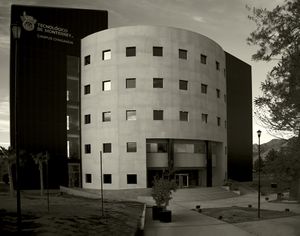
المناخ
| بيانات المناخ لـ مدينة چيواوا (1981–2000، درجات الحرارة العظمى 1932–2000) | |||||||||||||
|---|---|---|---|---|---|---|---|---|---|---|---|---|---|
| الشهر | ينا | فب | مار | أبر | ماي | يون | يول | أغس | سبت | أكت | نوف | ديس | السنة |
| القصوى القياسية °س (°ف) | 30.0 (86.0) |
32.0 (89.6) |
34.0 (93.2) |
38.8 (101.8) |
39.6 (103.3) |
41.4 (106.5) |
41.6 (106.9) |
39.2 (102.6) |
39.0 (102.2) |
35.0 (95.0) |
34.6 (94.3) |
29.0 (84.2) |
41.6 (106.9) |
| متوسط القصوى اليومية °س (°ف) | 18.1 (64.6) |
21.2 (70.2) |
24.2 (75.6) |
27.9 (82.2) |
32.2 (90.0) |
34.0 (93.2) |
32.1 (89.8) |
30.3 (86.5) |
29.2 (84.6) |
26.8 (80.2) |
21.9 (71.4) |
18.2 (64.8) |
26.3 (79.3) |
| المتوسط اليومي °س (°ف) | 10.0 (50.0) |
12.9 (55.2) |
15.7 (60.3) |
19.2 (66.6) |
23.6 (74.5) |
26.3 (79.3) |
25.6 (78.1) |
24.3 (75.7) |
22.6 (72.7) |
18.7 (65.7) |
13.7 (56.7) |
10.3 (50.5) |
18.6 (65.5) |
| متوسط الدنيا اليومية °س (°ف) | 2.0 (35.6) |
4.5 (40.1) |
7.1 (44.8) |
10.4 (50.7) |
14.9 (58.8) |
18.6 (65.5) |
19.1 (66.4) |
18.2 (64.8) |
16.0 (60.8) |
10.7 (51.3) |
5.5 (41.9) |
2.4 (36.3) |
10.8 (51.4) |
| الصغرى القياسية °س (°ف) | −12.8 (9.0) |
−18.0 (−0.4) |
−5.8 (21.6) |
−3.4 (25.9) |
3.8 (38.8) |
6.1 (43.0) |
10.6 (51.1) |
10.0 (50.0) |
3.7 (38.7) |
−2.4 (27.7) |
−6.1 (21.0) |
−11.5 (11.3) |
−18.0 (−0.4) |
| متوسط تساقط الأمطار mm (inches) | 9.9 (0.39) |
3.7 (0.15) |
7.7 (0.30) |
12.9 (0.51) |
26.1 (1.03) |
34.7 (1.37) |
94.7 (3.73) |
89.3 (3.52) |
66.4 (2.61) |
21.6 (0.85) |
8.7 (0.34) |
9.9 (0.39) |
385.7 (15.19) |
| Average precipitation days (≥ 0.1 mm) | 2.5 | 1.6 | 1.5 | 2.5 | 4.0 | 6.7 | 11.4 | 12.0 | 8.0 | 4.0 | 2.0 | 2.3 | 58.4 |
| متوسط الرطوبة النسبية (%) | 55 | 49 | 39 | 37 | 37 | 42 | 53 | 61 | 61 | 56 | 55 | 57 | 50 |
| Mean monthly ساعات سطوع الشمس | 185 | 204 | 254 | 278 | 299 | 273 | 240 | 242 | 229 | 238 | 191 | 174 | 2٬807 |
| Source 1: Servicio Meteorológico Nacional (normals and extremes 1981–2000),[19] Deutscher Wetterdienst (extremes 1932–1993, sun 1961–1990)[20][21][أ] | |||||||||||||
| Source 2: Colegio de Postgraduados (snowy days, 1951–1980)[22] | |||||||||||||
الجغرافيا
النقل
الجريمة
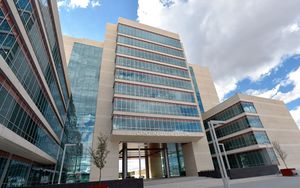
الرياضة
السياحة

المدن والبلدات الشقيقة
چيواوا على توأمة مع المدن والبلدات التالية: [24]
| البلد | المدينة | الولاية/المنطقة/المقاطعة | Ref. |
|---|---|---|---|
| ألبوكركي | [25] | ||
| پويبلو | [25] |
الهوامش
- ^ Station ID for Chihuahua is 76225 Use this station ID to locate the sunshine duration
المصادر
- ^ أ ب ت
 Chisholm, Hugh, ed. (1911). . دائرة المعارف البريطانية. Vol. 6 (eleventh ed.). Cambridge University Press. p. 134.
Chisholm, Hugh, ed. (1911). . دائرة المعارف البريطانية. Vol. 6 (eleventh ed.). Cambridge University Press. p. 134. {{cite encyclopedia}}: Cite has empty unknown parameter:|coauthors=(help) - ^
"Constitución Política del Estado Libre y Soberano de Chihuahua" (PDF) (in Spanish). H. Congreso del Estado de Chihuahua. July 2010. p. 11. Archived from the original (PDF) on August 16, 2010. Retrieved May 15, 2013.
{{cite web}}: CS1 maint: unrecognized language (link) - ^ أ ب "Archived copy" (PDF). Archived from the original (PDF) on 2011-10-11. Retrieved 2012-01-25.
{{cite web}}: CS1 maint: archived copy as title (link) - ^ "Chihuahua: Etimología". Archived from the original on 2007-07-01. Retrieved 2007-10-07.
- ^ أ ب Almada Francisco R (1968). Diccionario de Historia, Geografía y Biografía Chihuahuenses (in الإسبانية). Universidad de Chihuahua.
- ^ Salvador Treviño Castro (2000). Del Chihuahua colonial (in الإسبانية). UACJ. p. 27. ISBN 968-7845-24-4. Archived from the original on 2023-07-30. Retrieved 2020-11-09.
- ^ "Chihuahua: Historia". Archived from the original on 2007-06-29. Retrieved 2007-10-07.
- ^ Martin, Cheryl (1996). Governance and Society in Colonial Mexico: Chihuahua in the Eighteenth Century. Stanford University Press. pp. 1–2. ISBN 9780804741682. Archived from the original on July 30, 2023. Retrieved January 29, 2013.
- ^ Diario, Juan Carlos Núnez / El. "Rinde protesta Eugenio Baeza como alcalde de Chihuahua". Archived from the original on 2016-01-10. Retrieved 2016-02-11.
- ^ Diario, Juan Carlos Núñez/ - El. "Regresa Garfio a la alcaldía de Chihuahua". Archived from the original on 2017-04-13. Retrieved 2017-04-12.
- ^ "Documents" (PDF). www.ieechihuahua.org.mx. Archived (PDF) from the original on 2017-01-10. Retrieved 2017-04-12.
- ^ Redacción, De la. "Toma de protesta de Maru Campos". Archived from the original on 2017-04-13. Retrieved 2017-04-12.
- ^ "300 years of the founding of Chihuahua". Archived from the original on 2015-06-26. Retrieved 2019-09-10.
- ^ Altamirano, 1988: 49.
- ^ Altamirano, 1988: 93.
- ^ "Chihuahua - Chihuahua". www.e-local.gob.mx. Archived from the original on 2 December 2013. Retrieved 11 January 2022.
- ^ "Chihuahua". Catálogo de Localidades. Secretaría de Desarrollo Social (SEDESOL). Retrieved 23 April 2014.
- ^ أ ب ت [1] Archived أكتوبر 15, 2009 at the Wayback Machine
- ^ "NORMALES CLIMATOLÓGICAS 1981–2000" (PDF) (in Spanish). Comision Nacional del Agua. Archived from the original (PDF) on March 3, 2016. Retrieved January 23, 2016.
{{cite web}}: Unknown parameter|deadurl=ignored (|url-status=suggested) (help)CS1 maint: unrecognized language (link) - ^
"Klimatafel von Chihuahua, Chihuahua / Mexiko" (PDF). Baseline climate means (1961-1990) from stations all over the world (in German). Deutscher Wetterdienst. Retrieved January 23, 2016.
{{cite web}}: CS1 maint: unrecognized language (link) - ^ "Station 76225: Chihuahua". Global station data 1961–1990—Sunshine Duration. Deutscher Wetterdienst. Retrieved January 23, 2016.
- ^ "Normales climatológicas para el Estado de Chihuahua" (in Spanish). Colegio de Postgraduados. Archived from the original on April 19, 2012. Retrieved 18 September 2012.
{{cite web}}: CS1 maint: unrecognized language (link) - ^ "Hoy inaugura EPN Centro de Justicia en Chihuahua, el más grande LA". Radio Formula. Archived from the original on 7 February 2016. Retrieved 6 February 2016.
{{cite web}}: Unknown parameter|deadurl=ignored (|url-status=suggested) (help) - ^ [2] Archived أكتوبر 25, 2008 at the Wayback Machine
- ^ أ ب "Interactive City Directory". Retrieved 25 June 2015.
المراجع
وصلات خارجية
 Chihuahua travel guide from Wikivoyage
Chihuahua travel guide from Wikivoyage- (بالإسپانية)−Official City of Chihuahua website
- (بالإسپانية)−Economic Development Office
- Chihuahua video
- Chihuahuan Frontier
- Pages using gadget WikiMiniAtlas
- مقالات المعرفة المحتوية على معلومات من دائرة المعارف البريطانية طبعة 1911
- CS1 الإسبانية-language sources (es)
- CS1 errors: unsupported parameter
- Short description is different from Wikidata
- Articles containing Lipan Apache-language text
- Articles containing إسپانية-language text
- Pages using infobox settlement with possible motto list
- Coordinates on Wikidata
- Pages using Lang-xx templates
- Pages with إسپانية IPA
- Articles with unsourced statements from January 2023
- Articles with hatnote templates targeting a nonexistent page
- Articles with unsourced statements from February 2017
- Pages with empty portal template
- مدينة چيواوا
- مدن المكسيك
- أماكن مأهولة في چيواوا (ولاية)
- عواصم ولايات المكسيك
- أماكن مأهولة تأسست في 1709
- تأسيسات 1709 في إسپانيا الجديدة
- تأسيسات عقد 1700 في المكسيك
- 1709 في المكسيك


